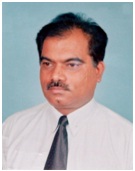biography
Dr.Gurudutta Gangenahalli, FICS, FNA Biol Sci’s, FICI (Ire), FRAM (Ire), FRSC(UK), FRSB (UK), FRSM (UK), presently an Additional Director & Founding Head of the Division of Stem Cell Research at Institute of Nuclear Medicine and Allied Sciences (INMAS), DRDO, Delhi, India. He has made several original & novel discoveries, especially in understanding the therapeutic potential human stem cell fate response signaling, such as Apoptosis, Adherence, Osteogenesis, Differentiation, Homing, by using
Area of Interest
Therapeutic potential human stem cell fate response signaling, such as Apoptosis, Adherence, Osteogenesis, Differentiation, Homing, by using
top publication
1. Early monitoring and quantitative evaluation of macrophage infiltration after
2. Therapeutic
3. Potential stem cell labeling ability of poly-L-lysine complexed to ultrasmall iron oxide contrast agent: An optimization and relaxometry study. Sushant Mishra, Subash
4. Gene expression profiling of human c-Kit mutant D816V. Shilpa Sharma, GURUDUTTA Gangenahalli*. Journal of Cancer Therapy(Scientific Research Publishing), 2016, 7, 439-454.(* Corresponding Author).
5. Umbilical Cord Blood Transplantation: Clinical Challenges. Shilpa Sharma and Gurudutta Gangenahalli* (*Corresponding Author).International Journal of Stem Cell Research and Transplantation (Sci Doc Publishers, England), 3 (6),134-141, 2015.
6. Maxillofacial Musculoskeletal Diseases. Manu Krishnan*, Gurudutta Gangenahalli, Satish R. Iyer and Sanjay Londhe.Austin Journal of Musculoskeletal Disorders (2015).2, 2, 1-20, 2015.
7. Adult hematopoietic stem cells: Niche cross-talks to affect the cell. Shilpa Sharma and Gurudutta Gangenahalli* (*Corresponding Author). Niche Journal (Journal of Cellular Therapy & Regenerative Medicine Society. Turkey). DOI:10.5152/Niche.2015.214.
8. Epigenetic regulation of hematopoietic stem cells. Shilpa Sharma and Gurudutta Gangenahalli* (*Corresponding Author). InternationalJournal of stem cells (Sci
9. Electrophoretic detection of alginate by Hematoxylin and Eosin fluorescence: Implications in cell encapsulation/ tissue engineering. Yogesh Verma and Gurudutta Gangenahalli* (*Corresponding Author). Reactive & Functional polymers (Elsevier).) 102, 130–136, 2016.
10. Increased transverse relaxivity in ultrasmall superparamagnetic iron oxide nanoparticles: Applications as MRI contrast agent for biomedical imaging. Sushant Mishra, Subash
11. Conformal coating (encapsulation) of human single cells by biodegradable chitosan
12. Transgene expression study of CXCR4 active mutants: Potential prospects in up-modulation of homing and engraftment efficiency
13. Human T-Cell line (Jurkat cell) Encapsulation by Nano-organized Polyelectrolytes and their Response Assessment in vitro and in vivo." Siddharth Pandey, GURUDUTTAGangenahalli*, Farhat Afrin et al. Journal of Nanoparticle Research. 15:1793. (Springer). 2013.Impact Factor: 3.29 (2012). (*Corresponding Author).
14. High-throughput transcriptome profiling of bone
15. Regulated expression of CXCR4 constitutive active mutants’ revealed up-modulated chemotaxis and
16. Enhanced hetero-dimerization of Bax by Bcl-2 mutants improves irradiated hematopoietic cell survival. Yogesh Kumar
17. Molecular Dynamics Simulations of Bcl-2 Protein to Predict the Structure of its Unordered Flexible Loop Domain. Pawan Kumar Raghav, Yogesh Kumar Verma, GURUDUTTA Gangenahalli* et al. Journal of Molecular Modelling (Springer, USA) 18, 5, 1885-1906, 2012.Impact Factor: 1.8(2011). (*Corresponding Author).ISBN/ISSN No.1610-2940. 18.
21. Monitoring of the in-situ thymine photo-adduct using
22. Characterization of glutamine synthetase and ATPases in a mutant strain of the cyanobacterium Nostoc
23. The structural insights of stem cell factor receptor (c-kit) interaction with tyrosine phosphatase-2 (ShP-2): An in silico analysis. Soumya Pati.
G U GURUDUTTAet al.Bio-Med Central Research Notes. (BMC) (USA) (Open Access). 3:14-43. 2010. Impact Factor: Available in 2013 (See the letter attached from BMC office). (* Corresponding Author). ISBN/ISSN No: 1756-0500.
24.
25. Hematopoietic stem cell antigen CD34: role in adhesion or homing. G.U. GURUDUTTA *,

